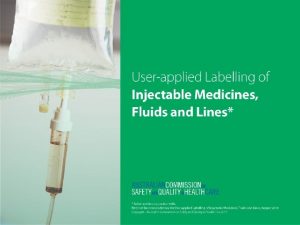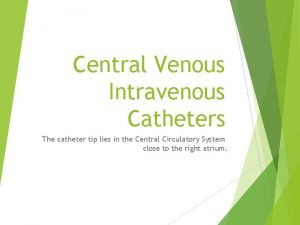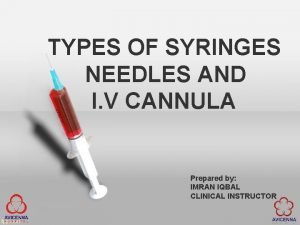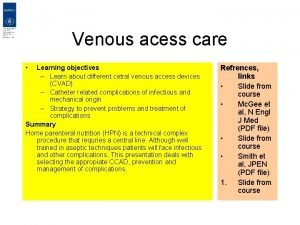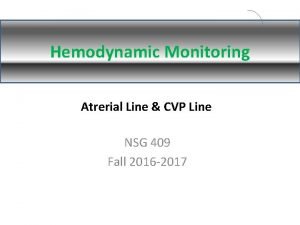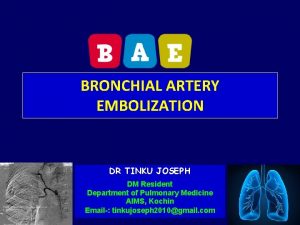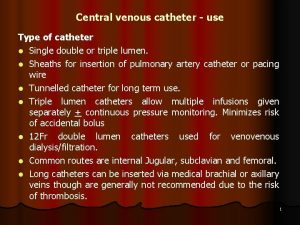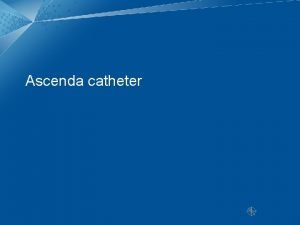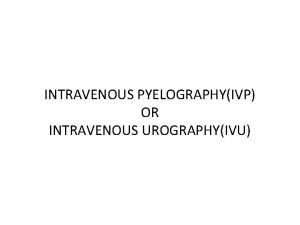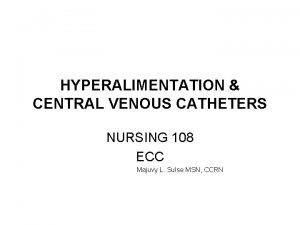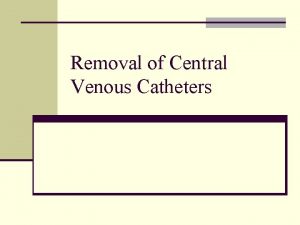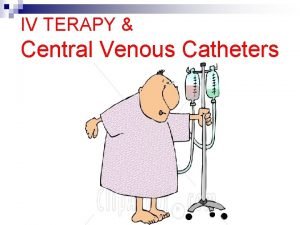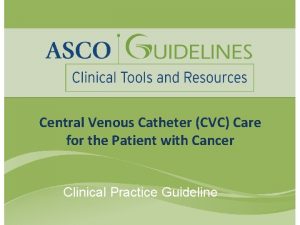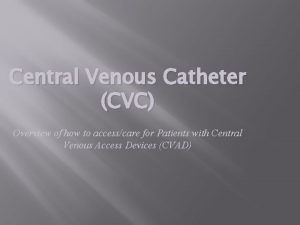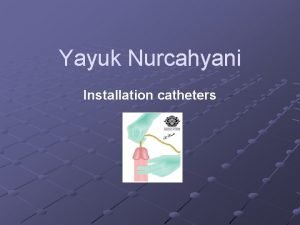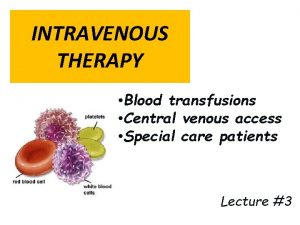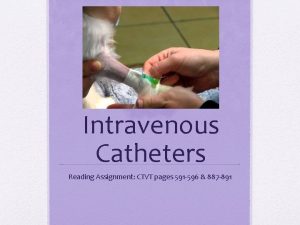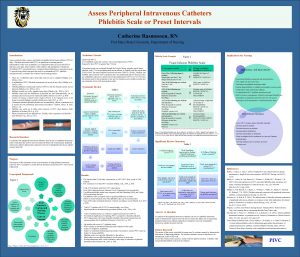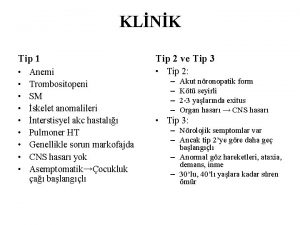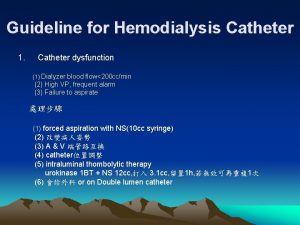Central Venous Intravenous Catheters The catheter tip lies




























- Slides: 28

Central Venous Intravenous Catheters The catheter tip lies in the Central Circulatory System close to the right atrium.

Objectives Central venous access Identify the types of central lines/implanted ports. Identify nursing responsibilities in the care of central venous catheters. Identify major complications of central venous catheters List the most common types of intravenous therapies infused via central venous access devices. List the equipment necessary to access an implanted port and central lines. 2

Objectives Blood Transfusion Identify various types of blood and blood products and reasons for their administration to a patient. Identify the risks of blood transfusion Discuss procedures to reduce the risk of blood transfusion reactions Discuss nursing intervention for the patient with a transfusion reaction Identify the essential steps necessary in the safe administration of blood and blood products to a patient. 3

Central lines empty into a central vein which applies to the location of the catheter tip not to the insertion site. Peripherally inserted central catheters (PICC lines)enter a peripherally arm vein and extend through the venous system to the superior vena cava where they terminate. Other central lines enter a central vein such as the subclavian or jugular vein or tunneled through subcutenous tissue.

Central line Catheters Central lines effective for large volumes of fluids, parenteral nutrition, and medications or fluids that irritate veins. Proper care is critical to prevent catheter-related bloodstream infections( CRBSI) Nursing responsibilities for central lines include careful monitoring, flushing to keep the line patent, and site care and dressing changes.

Central lines Catheters 6

Central Catheters A Hickman line is a central venous catheter most often used for the administration of chemotherapy or other medications, as well as for the withdrawal of blood for analysis. Some types are used mainly for the purpose of apheresis or dialysis.

Groshung Catheter 8

Broviac catheter 9

Port a Cath 10

Three- lumen catheter 11

3 lumen catheter Distal port for blood sampling –this is the largest 16 gauge Medial port for parenteral and nutrition- 18 g Proximal port for medication administration- 18 g 12

Objectives for administering blood transfusions Increase circulating blood volume after surgery, trauma, or hemorrhage Increase the number of RBC and maintaining hemoglobin levels in patients with severe anemia Proving selected cellular components as replacement therapy ( clotting factors, platelets, albumin Avoid incompatibility blood transfusion must be matched to each patient. 13

Blood Types Chart/blood group There are eight different common blood types determined by the presence or absence of certain antigens. Safe blood transfusions depends on careful blood typing and cross-matching. The Universal red cell donor has type O negative blood type. The universal plasma donor has type AB blood type. 14

The ABO blood group System Group A- has only A antigen on red cells(B antibody in the plasma) Group B- has only B antigen on red cells (A antibody in the plasma) Group AB- has both A and B antigens on red cells (but neither A nor B antibody in the plasma) Group O- has neither A nor B antigens on red cells( but both A and B antibody are in the plasma) 15

Blood types must be matched for a safe transfusion. Group O can donate red blood cells to anybody. It’s the universal donor. Group A can donate red blood cells to A’s and AB’s Group B can donate red blood cells to B’s and AB’s. Group AB can donate to other AB’s, but can receive from all others. 16

Antigens Third antigen called the Rh factor, which can be present (+)or absent(-) Rh negative blood is given to Rh negative patients, and Rh positive blood or Rh negative blood may be given to Rh positive patients. The universal red blood cell donor has type O negative blood type. The universal plasma donor has Type AB blood type. 17

Antibody An Antibody is a protein that the immune system produces to neutralize a threat to the body 18

Blood type and the population Studies- Hispanic people , have a high number of O’s Donor and recipient are from the same ethnic background the chance of a reaction can be reduced. Blood types is inherited. Whether your blood group is type A, B, AB, or O is based on the blood types of your mother and father. 19

Blood Transfusion Blood component therapy = IV administration of whole blood or blood component- (packed red blood cells, platelets, or plasma) Blood groups and types: Packed red blood cells -Donor O Type O blood is the universal donor for RBC Fresh –frozen plasma- Donor –O Recipient-O Type AB Blood is the universal donor for plasma Platelets- Donor O Recipient O, A, B, AB Autologous transfusion-collection and reinfusion of patient’s own blood. Transfusing blood- requires an order Patient safety is a nursing priority. Recipient- O, A, B, AB

Tubing for Transfusions

Unit of packed cells Normal Saline 22

Blood transfusion Reaction Allergic reaction –hives, pruritus, facial flushing, severe shortness of breath and bronchospasm Febrile reaction- chills, fever, headaches, flashing, nausea and vomiting and increase anxiety. Hemolytic transfusion reaction: Low back pain, hypotension, burning sensation along the vien, fever 105 or higher, chest pain, labored respirations, headache, immediate onset. 23

Transfusion Reactions Nursing Implications Stop the transfusion Change IV tubing and start a normal saline drip Treat shock if present –O 2, fluids, epinephrine as ordered. Immediately notify health care provider. Remain with patient and take vital signs every 5 minutes. Prepare to administer emergency drugs Antihistamines, vasopressors, fluids, and cortisteroids Prepare to perform CPR Save blood tubing, bag, attached labels, and transfusion record for return to the blood bank.

Continue Acute adverse effects that do not involve an immune response to the blood components also can occur during transfusion. Circulatory overload when patient receives massive transfusions. Older adults at risk and those with circulatory overload. Blood transfusion contaminated with bacteria, especially gram negative bacteria, can cause sepsis. Disease transmitted by blood from infected donors Hepatitis B and C , Human immunodeficiency virus infection, and acquired immunodeficiency syndrome. 25

Legal issues –vascular access The decision of the kind of vascular access proposed to patients Is the choice tunneled or nontunneled The risk of complications A complete informative easy to understand consent form. The use of ultrasound guidance for cannulation The use of floroscopy for checking the position of the metal guidewire during the procedure as well as the CVC tip before end of the procedure. Inappropriate catheter care. 26

Legal issues- blood transfusion Obtain the patient’s informed consent before administering blood products. Include explaining to the patient the benefits and risks of receiving and not receiving the blood product. 27

Thank you 28
 Line & catheter label - intravenous burette
Line & catheter label - intravenous burette Line & catheter label - intravenous burette
Line & catheter label - intravenous burette Line & catheter label - intravenous burette
Line & catheter label - intravenous burette Groshung
Groshung Most common complication of central venous catheter
Most common complication of central venous catheter Chapter 25 urinary catheters
Chapter 25 urinary catheters Sıcak evin direği tıp tıp eder yüreği
Sıcak evin direği tıp tıp eder yüreği Intravenous medication administration pretest
Intravenous medication administration pretest Intravenous medication administration pretest
Intravenous medication administration pretest Cannula sizes
Cannula sizes Angle for iv insertion
Angle for iv insertion Give 3 words each that is associated with parts
Give 3 words each that is associated with parts Mechanical phlebitis signs and symptoms
Mechanical phlebitis signs and symptoms Central venous acess
Central venous acess Over dampened arterial line
Over dampened arterial line Double lumen hickman line
Double lumen hickman line Central venous pressure monitoring for nurses
Central venous pressure monitoring for nurses Wallace embryo transfer catheter
Wallace embryo transfer catheter Macy catheter medication administration
Macy catheter medication administration Fiber optic force sensing catheter
Fiber optic force sensing catheter Imperio datafile.com
Imperio datafile.com Pa catheter normal values
Pa catheter normal values Farco fill protect
Farco fill protect Bromage scale
Bromage scale Mikaelson catheter
Mikaelson catheter Lytic catheter
Lytic catheter Swan ganz catherter
Swan ganz catherter Micturition
Micturition Mavic 400 ai catheter
Mavic 400 ai catheter
